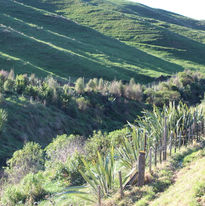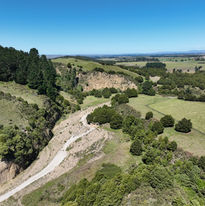MANGAONUKU
CATCHMENT
Primary township Tikokino
Area 34,863ha
Land use 78 percent of the catchment is in pasture, 14 percent in exotic forest and 6 percent in indigenous forest.
CATCHMENT
GROUP
Committee Tom Wilson, Grant Charteris, Hugh Abbiss, Charlie Graham, George Williams, Mike Rittson-Thomas
Catchment co-ordinator Kahlia Fryer
Email tukitukicoordinator@gmail.com
Phone 0273426071


ABOUT OUR CATCHMENT
The Mangaonuku catchment spans 34,863ha, originating from the foothills of the Wakarara Range and flowing into the Waipawa River.
Water quality is a key concern in the catchment, with elevated nitrogen and phosphorus levels often exceeding recommended standards, particularly after rainfall events.
Gully erosion contributes heavily to sedimentation despite the benefits of riparian fencing and forestry efforts, which have improved streambank stability. The steep terrain and level of flows in parts of the catchment further complicate management.
THE BIG PICTURE
The Big Picture
As part of The Big Picture project, TLC has developed independent, science-backed catchment plans for each of the 17 sub-catchments of the Tukituki River. These farmer-led plans address key environmental challenges specific to each area while identifying practical, affordable solutions. These plans do not impose rules or regulations but they give farmers and catchment groups a roadmap for future planning to improve water quality, boost farm productivity, and open the door to future funding opportunities.
TLC partnered with environmental planning consultancy Environment, Innovation and Strategy Ltd (EIS), who collected data specific to each sub-catchment, including erosion maps, flow path models, land use capability, soil types, and water monitoring information. Alongside the scientific data, in December 2024, TLC hosted workshops for farmers and growers in each sub-catchment to make sure the solutions aligned with the realities of farming and growing in each sub-catchment.
Mangaonuku Draft Sub-Catchment Plan: Summary
Mangaonuku Draft Sub-Catchment Plan: Full Report
Mangaonuku Catchment Maps
TLC FARMER TOOLBOX
Tools for the Mangaonuku Catchment
As part of The Big Picture, TLC has developed the TLC Farmer Toolbox, designed to support landowners in making informed decisions and enable them to implement changes with confidence, ensuring that time and money are invested wisely.
The TLC Toolbox includes the following:
-
TLC’s On-Farm Action Planning Tool - prioritise on-farm environmental actions based on their cost-effectiveness and impact.
-
TLC’s Plant Selection Tool - choose the right plants for on-farm environmental projects by matching your planting zone and purpose with suitable species.
-
TLC’s Surface Erosion Tool - determine the most erosion-prone areas on your farm to identify priority sites for effective soil conservation measures.
-
TLC’s Water Runoff Mapping Tool - identify sites for on-farm edge-of-field mitigations such as sediment traps, constructed wetlands and detention bunds.
-
TLC’s Riparian Mapping Tool - better understand riparian condition and vegetation class along waterways to prioritise where riparian management should occur.
-
TLC’s ETS Guide- download TLC’s ETS Guide for key information on the Emissions Trading Scheme, including its purpose, benefits, eligibility, enrolment process, and potential costs and returns.
-
TLC’s Willow Management Guide - download TLC’s Invasive Willow Management Guide for insights on willows in the Tukituki, control strategies and riparian restoration.
-
TLC’s List Of Advisors - connect with local advisors for tailored advice and potential funding opportunities.

















